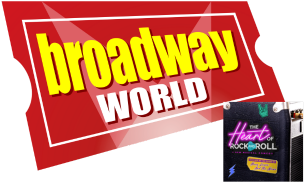BWW Reviews: Brit Floyd Bends Genres, Minds at the Benedum Center
Let me get the essentials of this review out of the way first- Brit Floyd puts on a very good show. The musicians are top-notch, the singers are phenomenal and the visual effects are unbelievably immersive. Everyone in the Benedum Center on Saturday night had an amazing time, myself included. If that were all I had to say, this review would be shallow at best, pointless at worst-- after all, I am a theatre columnist more than a rock journalist (despite being a lifelong music aficionado and a Pink Floyd diehard). But instead of leaving the theatre last night simply thinking, "Man, what a great band," I found myself questioning where the line is drawn between "theatre" and "not theatre."
Brit Floyd occupies an unusual space as a Pink Floyd tribute act, somewhere between being merely a dedicated cover band and the sort of "character impersonator" theatrical bands commonly associated with The Beatles or Elvis Presley. The band members all dress like Pink Floyd during their most creatively-fruitful years... but the Pink Floyd uniform of that era was generic, basic black. When a band such as Pink Floyd crafts its image around visual anonymity, can one dress like or "impersonate" them at all? There was no effort made to impersonate or pretend to be Roger Waters or David Gilmour, the two (occasionally literally) dueling frontmen of Pink Floyd... until, after intermission, there suddenly was, as bassist-vocalist Ian Cattell stepped into the role and mannerisms of Roger Waters for a theatrical vocal solo from "The Final Cut." This song, the Andrew-Lloyd-Webber-ish "Fletcher Memorial Home," is a pure acting piece, much more a show tune than a rock song, which illustrates not only the essential theatricality of Pink Floyd's canon under Waters, but the inadequacy of calling Pink Floyd a "rock band" at all, when considering their mix of rock, classical, jazz, bebop, opera and theatre music.
The three-hour concert, named "Discovery" after the complete Pink Floyd box set released earlier this decade, is not necessarily a greatest hits tour- in fact, the most famous Pink Floyd hit of all, "Money," is not played. Rather, the music seems to be assembled into a retro-fitted concept album format, abandoning chronology in order to use the band's often insular lyrics to tell the story of Pink Floyd and its metamorphoses over the years. The lyrical focus is on strife, struggle and loss, as the band moves from a psychedelic, experimental group in the Sixties to the deeply cynical progressive arena rockers of the Seventies, into the wounded but ultimately more peaceful final iteration in the Eighties and Nineties. Projections aid this loose storytelling device, illustrating the often oblique lyrics with often poignant photos and videos of Syd Barrett, the "crazy diamond" whose psychedelic indulgences led him to madness and nearly doomed the band, and of Roger Waters, the arrogant, paranoid genius who replaced him as the band's creative force before an acrimonious breakup in the mid-Eighties. Most of the post-Waters material which makes up the early part of the show is from the perspective of David Gilmour, the guitarist and co-lead vocalist who tied the group together from the Barrett years through the post-Waters period.
Beyond the biographical, quasi-storytelling elements, Brit Floyd continues Pink Floyd's tradition of blending concert performance with visual and sensory stimuli with a light show, projections and cinematics designed by Bryan Kolupski, taking heavy inspiration from the iconic multimedia creations of Hipgnosis and Gerald Scarfe for the original Pink Floyd tours. During the "overture," the lengthy semi-instrumental "Shine On You Crazy Diamond" suite, animated projections bring the iconic Pink Floyd mascots and characters from album art to life, both the obvious choices (Pink and the Teacher from "The Wall," the Easter Island heads from "The Division Bell) and more obscure figures (the lightbulb man from "Delicate Sound of Thunder," the pinioned lovers from "A Collection of Really Great Dance Songs"). The entire evening is performed to similarly complex and visually astounding lights, projections and animations, while the band, visually, often plays second banana. Exceptions to this include a front-and-center solo by multi-instrumentalist Carl Brunsdon on two saxophones simultaneously, and the extended guitar intro to "Sorrow," in which lead guitarist and music director Damian Darlington performs on a black stage, illuminated by a prismatic spotlight whose shifting colors and triangular shape call to mind the "Dark Side of the Moon" logo. Anchoring much of the show, both visually and musically, is the solemn, almost sinister presence of Angela Cervantes, Jacquie Williams and Emily Jollands as the "gospel trio," who slowly dance on and offstage in perfect synchronization with the moody music.
In the final moments of the concert, right before the encore, the line between "concert," "theatre" and "spectacle" broke down entirely. All the lights went out, and a sound collage began to play. When the lights came up again, a roadie had appeared center stage, passed out in a chair next to a table lamp and a small television, mimicking a famous scene from the film and touring concert/stage show of "The Wall." To make things even more meta-theatrical, the television at his side was playing the movie version of "The Wall." (Dedicated Pink Floyd fans in the audience cheered here, knowing what was coming.) Sure enough, bassist Cattell had been replaced by multi-instrumentalist Brunsdon in his former location, and moments into the song, "Comfortably Numb," Cattell walks out dressed as a doctor- or more precisely, dressed as Roger Waters as a doctor. He sings the song in character, attempting to revive the comatose roadie (filling in for iconic character Pink, who would traditionally be played by Roger Waters as well) with a syringe of heroin. Is Cattell the Doctor now? Is he Roger as the Doctor? A role is being played, but exactly who or what it is is obscure. Then again, any Pink Floyd fan will tell you that obscure is sometimes the point.
Videos
